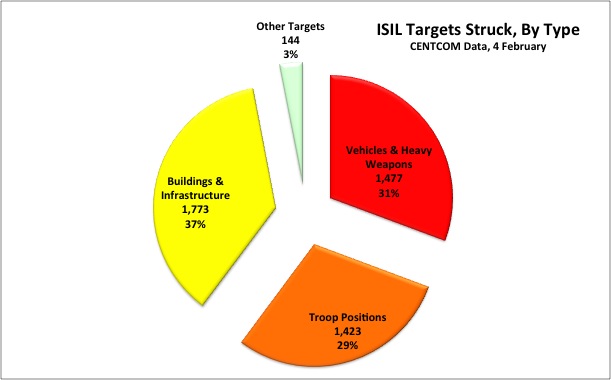4,817 Targets: How Six Months Of Airstrikes Have Hurt ISIL (Or Not)
http://breakingdefense.com/2015/02/4817-targets-how-six-months-of-airstrikes-have-hurt-isil-or-not/
4,817 Targets: How Six Months Of Airstrikes Have Hurt ISIL (Or Not)
By Sydney J. Freedberg Jr. on February 11, 2015 at 5:07 PM
The war is escalating. But what have six months of airstrikes against the self-proclaimed Islamic State actually achieved so far?
Last week, Jordan launched its retaliation against the Islamic State for burning a Jordanian pilot alive. Yesterday, we learned ISIL had murdered hostage Kayla Mueller. This morning, President Obama formally proposed a new Authorization for the Use of Military Force (AUMF) against ISIL, eliciting ambivalent comments from Congress (more on that below). The crucial question: how much leeway to leave for the future use of US ground troops.
This afternoon, US Central Command (CENTCOM) released its most detailed data yet on what the current airstrikes-only approach has accomplished so far. (We’ve analyzed earlier data here, here, and here). It counts 4,817 targets damaged or destroyed as of February 4th by the US and its coalition partners. The list is broken down into 28 categories, from 752 “fighting positions” — e.g. foxholes — to seven items of “communications equipment.” We thought we’d aggregate that a little for you:

One fact leaps out: This is close air support against enemy ground troops, not the surgical strikes against strategic targets that the Air Force was born for. Almost two-thirds of targets struck are troops, forward positions, and vehicles; just one-third are buildings and other fixed infrastructure. This is an imperfect indicator, since some buildings may be temporary staging positions close to the front line, and some troops may be hit far to the rear. Overall, though, the 2:1 ratio in targets by type indicates the air campaign is emphasizing ISIL’s forward fighting forces — what pilots once derided as “tank plinking” — rather than its rear support structure.






